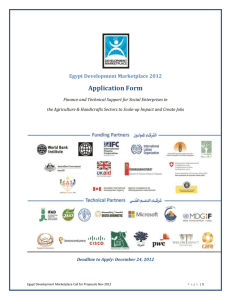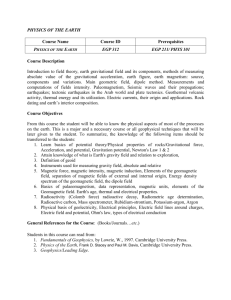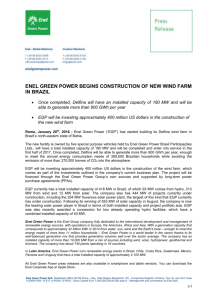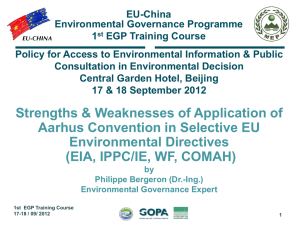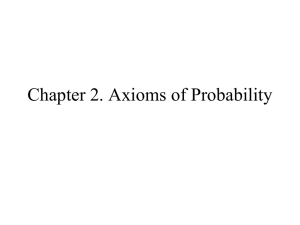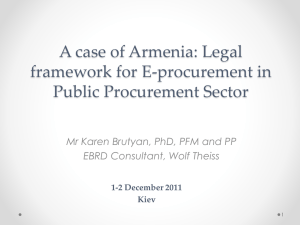AJP Journal - Bryn Mawr College
advertisement
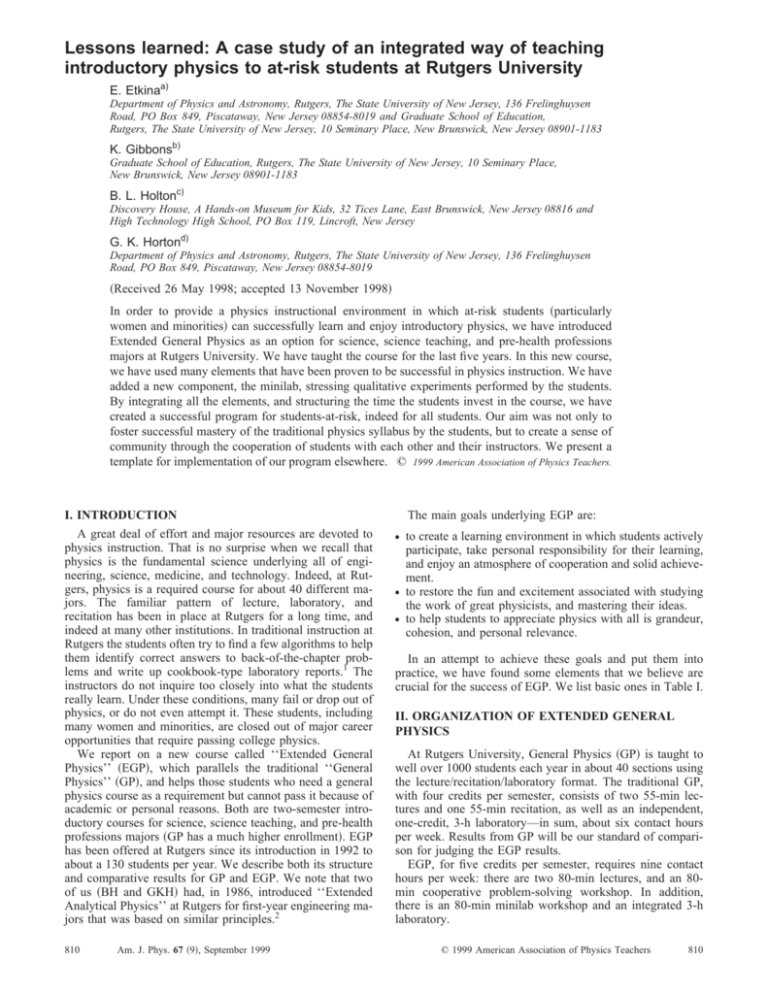
Lessons learned: A case study of an integrated way of teaching introductory physics to at-risk students at Rutgers University E. Etkinaa) Department of Physics and Astronomy, Rutgers, The State University of New Jersey, 136 Frelinghuysen Road, PO Box 849, Piscataway, New Jersey 08854-8019 and Graduate School of Education, Rutgers, The State University of New Jersey, 10 Seminary Place, New Brunswick, New Jersey 08901-1183 K. Gibbonsb) Graduate School of Education, Rutgers, The State University of New Jersey, 10 Seminary Place, New Brunswick, New Jersey 08901-1183 B. L. Holtonc) Discovery House, A Hands-on Museum for Kids, 32 Tices Lane, East Brunswick, New Jersey 08816 and High Technology High School, PO Box 119, Lincroft, New Jersey G. K. Hortond) Department of Physics and Astronomy, Rutgers, The State University of New Jersey, 136 Frelinghuysen Road, PO Box 849, Piscataway, New Jersey 08854-8019 共Received 26 May 1998; accepted 13 November 1998兲 In order to provide a physics instructional environment in which at-risk students 共particularly women and minorities兲 can successfully learn and enjoy introductory physics, we have introduced Extended General Physics as an option for science, science teaching, and pre-health professions majors at Rutgers University. We have taught the course for the last five years. In this new course, we have used many elements that have been proven to be successful in physics instruction. We have added a new component, the minilab, stressing qualitative experiments performed by the students. By integrating all the elements, and structuring the time the students invest in the course, we have created a successful program for students-at-risk, indeed for all students. Our aim was not only to foster successful mastery of the traditional physics syllabus by the students, but to create a sense of community through the cooperation of students with each other and their instructors. We present a template for implementation of our program elsewhere. © 1999 American Association of Physics Teachers. I. INTRODUCTION A great deal of effort and major resources are devoted to physics instruction. That is no surprise when we recall that physics is the fundamental science underlying all of engineering, science, medicine, and technology. Indeed, at Rutgers, physics is a required course for about 40 different majors. The familiar pattern of lecture, laboratory, and recitation has been in place at Rutgers for a long time, and indeed at many other institutions. In traditional instruction at Rutgers the students often try to find a few algorithms to help them identify correct answers to back-of-the-chapter problems and write up cookbook-type laboratory reports.1 The instructors do not inquire too closely into what the students really learn. Under these conditions, many fail or drop out of physics, or do not even attempt it. These students, including many women and minorities, are closed out of major career opportunities that require passing college physics. We report on a new course called ‘‘Extended General Physics’’ 共EGP兲, which parallels the traditional ‘‘General Physics’’ 共GP兲, and helps those students who need a general physics course as a requirement but cannot pass it because of academic or personal reasons. Both are two-semester introductory courses for science, science teaching, and pre-health professions majors 共GP has a much higher enrollment兲. EGP has been offered at Rutgers since its introduction in 1992 to about a 130 students per year. We describe both its structure and comparative results for GP and EGP. We note that two of us 共BH and GKH兲 had, in 1986, introduced ‘‘Extended Analytical Physics’’ at Rutgers for first-year engineering majors that was based on similar principles.2 810 Am. J. Phys. 67 共9兲, September 1999 The main goals underlying EGP are: 䊉 䊉 䊉 to create a learning environment in which students actively participate, take personal responsibility for their learning, and enjoy an atmosphere of cooperation and solid achievement. to restore the fun and excitement associated with studying the work of great physicists, and mastering their ideas. to help students to appreciate physics with all is grandeur, cohesion, and personal relevance. In an attempt to achieve these goals and put them into practice, we have found some elements that we believe are crucial for the success of EGP. We list basic ones in Table I. II. ORGANIZATION OF EXTENDED GENERAL PHYSICS At Rutgers University, General Physics 共GP兲 is taught to well over 1000 students each year in about 40 sections using the lecture/recitation/laboratory format. The traditional GP, with four credits per semester, consists of two 55-min lectures and one 55-min recitation, as well as an independent, one-credit, 3-h laboratory—in sum, about six contact hours per week. Results from GP will be our standard of comparison for judging the EGP results. EGP, for five credits per semester, requires nine contact hours per week: there are two 80-min lectures, and an 80min cooperative problem-solving workshop. In addition, there is an 80-min minilab workshop and an integrated 3-h laboratory. © 1999 American Association of Physics Teachers 810 Table I. Important elements for the success of EGP. Section size in the 16–20 student range Accessibility of the course staff easy, friendly, and creative access by students to the course coordinator, the professor in charge, and TAs Staff meetings weekly, one-hour, course staff meetings Math and Science Learning Centers friendly student-active facilities Weekly review sessions optional, structured review sessions Notebooks graded notebooks of rewritten lecture notes Minilabs short, qualitative hands-on experiments 共group work兲 Group problem-solving workshops recitations in which students solve Heller3 problems 共group work兲 Laboratories fully integrated and noncookbook 共group work兲 Interactive lectures physics lectures, with use of the instant student response system III. ESSENTIAL FEATURES OF EXTENDED GENERAL PHYSICS Here we elaborate on the major features of EGP. We are convinced that each of them is important for the success of EGP, but it is their supportive interplay that is vital to their combined effectiveness. A. Student selection All students admitted to EGP were personally interviewed by the course coordinator or the professor in charge to insure that there was a substantial reason to believe the student might do poorly in a traditional introductory physics course. Factors we looked for included a fear of physics, poor preparation, previous failure, or a low grade point average, especially in science or mathematics courses. Our judgment was to some extent subjective and we consulted in case of doubt. The first group of applicants were recommended by counselors of Equal Opportunity Fund 共EOF兲 students, the Success in the Sciences 共SIS兲 program for minority students majoring in the sciences, and the staff of the Douglass Project for Rutgers Women in Mathematics, Science and Engineering.4 The second group of students came from drop-outs and failing students from GP, the traditional course. The third group came to us through personal recommendations of EGP alumni and their friends. This represents a growing source of potential students and tapped a group that had not previously contemplated a science-based career. We made a good faith effort not to accept students who could pass GP well 共with a grade A or B兲 because of enrollment limitations. The resulting EGP student profile varied little from year to year, and featured a high percentage of women, 69% for EGP versus 47% for GP. There were dramatically higher percentages of African-American and Hispanic students, as shown quantitatively in Fig. 1. The EGP students have placed lower in first-year mathematics courses with a hundred point lower average math SAT score than that of GP students. 811 Am. J. Phys., Vol. 67, No. 9, September 1999 B. Section size Section size is important. We have kept each workshop and laboratory to 20 students or fewer. That, in our experience, is as many students as one instructor can reasonably supervise and still know personally. In GP, recitations are close to twice that size. But it is also important to keep section size above 16 students to promote student interactions. Careful attention to section size is a sure foundation of a successful EGP. C. ‘‘Cycled’’ structure of the course EGP instruction proceeds at the rate of a chapter per week and is organized in two-week cycles. During the first week of the cycle, two lectures are given, introducing the topic of the cycle. In the following week, the group problem-solving workshop, qualitative minilabs, quantitative laboratories 共with the quizzes兲, and review sessions on the same topic are held, while the lectures are simultaneously introducing a new topic. This system gives the students two weeks to master a given topic. The conceptual part is discussed in lectures, and the next week is dedicated to applying concepts to practical problems. These activities complement each other, approach- Fig. 1. Ethnic make-up of EGP and GP classes based on data for the 1992– 1996 period. Etkina et al. 811 ing the same topic from different perspectives. For example, during the week dedicated to wave optics, in group problem solving, the problems are based on interference in thin films and resolving power of different instruments. In the minilab, students strengthen their understanding of interference in general by working with a Michelson interferometer, and thin-film interference in particular by observing the colors of a soap bubble, flat glass plates with air between them, and Newton’s rings. After the workshops 共problem solving and minilab兲 the concept of diffraction is emphasized in the laboratory where students determine the wavelength of different light sources using slits and diffraction gratings. By the end of the second week of each cycle the students are ready for the topic ‘‘summary’’ that they ‘‘build together’’ with the course coordinator during optional, structured review sessions to which about half the class comes regularly. At first these sessions were designed to answer students questions with an attendance of 8–10. When structured review sessions by an experienced teacher were introduced, the attendance increased to 50–60 students per session. There was, therefore, no need to require attendance. Our goal was to help students build a ‘‘big picture’’ 5 of the material. This was done through a series of questions about the relationship among the concepts introduced in the lectures and the concepts on which workshops, laboratories, and homework problems were based. D. Student support We hold weekly, 1-h EGP course meetings with the instructors, course coordinator, and the laboratory technician at which the week’s program, student progress, and instructional techniques are discussed. We examine the needs of particular students or groups of students, and try to find appropriate strategies and follow-up. One of our goals is to ‘‘catch’’ those students who are falling behind as early as possible to help them to stay in class. The instructors in our course serve as facilitators rather than lecturers. Because the teaching methods that are used in the course are not traditional,6 it is very important to break the TAs’ stereotypes of what their teaching is supposed to be. We help the TAs to become familiar with good teaching methods—how to ask questions, how to generate students’ questions, how to elicit multiple representations, how to manage time in class, how to get feedback from the students, etc. We also discuss the most common difficulties that the students will encounter while learning a particular topic and how to anticipate them, as well as the most common misconceptions that the students might have. The course coordinator and the professor in charge advise TAs on how to organize a particular class, and the specifics of the weekly activity. TAs familiarize themselves with the experiments that the students will perform in both laboratory and minilab, and discuss problem solutions. We believe that only those TAs who feel comfortable with all aspects of the class content and laboratory equipment, and anticipate difficulties that the students will have with them, can handle their classes effectively. That is why we place such a serious emphasis on these meetings.7 To improve the quality of TA training one of the authors 共EE兲 started a new graduate course in the Physics Department, ‘‘Basics of Teaching Physics,’’ which most of the EGP TAs take. In addition, all instructors hold weekly office hours at our Math and Science Learning Centers 共MSLC兲,2 which are supportive and well-utilized facilities. These centers provide 812 Am. J. Phys., Vol. 67, No. 9, September 1999 a place where students can gather and study physics cooperatively by using the permanent demonstrations, video tapes of lectures and problem solutions, and the help of tutors who are available during extended hours. The atmosphere at these centers, where the staff provides help for the students, makes it possible to create the sense of community that is vital for the success of female and minority students.8 These resources are, of course, available to all physics students. The course coordinator’s office is located in the main MSLC, where she 共he兲 is always available for help. This creates a supportive, almost family-like, atmosphere. When the students know that there is always somebody to help them, who believes that they can succeed, their confidence gradually builds up. This frequently leads to real success. E. Instructor assignments Besides lectures, students attend a group problem-solving class, a minilab, and a laboratory every week. We have tried both having one instructor responsible for all the learning activities of a section, and having different instructors for the workshops and the laboratories. 共We have called the problem-solving recitations and minilabs, workshops. These two workshops are treated as a single unit for student registration. They are never split up for any reason because students work in the same group in both兲. We definitely favor the former arrangement. The choice of instructors 共TAs兲 and having their goodwill is important. We only accept volunteers. We interview possible candidates ahead of time and explain to them what we are doing and why. We do our best to help our co-workers to acquire the required skills so different from those needed for conventional teaching. We are seldom disappointed. Most TAs choose to serve several successive years. This is important for course continuity and stability. F. Textbook and course booklet There are several excellent texts available which are suitable for EGP. We have used the book by Cutnell and Johnson9 for several years, which provided continuity. It has been well-received by the students and the instructors. At the beginning of each semester, students buy a course booklet 共it is now available on-line兲 that describes all of the activities for each of the 14 weeks of the semester, including practice exams and their solutions. The students are expected to prepare for some activities in advance 共e.g., laboratories兲; we also encourage them to familiarize themselves with other activities before they come to class. The availability of the booklet helps students to develop time-management skills. An important feature of this booklet is the ‘‘introductory’’ pages that precede the materials for each week and help the students to identify the main ideas. These introductions consist of three parts: 共a兲 the new notions that students should be familiar with after that week 共e.g., thermal equilibrium, a quasi-static process, the efficiency of an engine, etc.兲, 共b兲 the main theme of the topic 共the three laws of thermodynamics兲, and 共c兲 the formulae that the students will find particularly useful. We emphasize the importance of 共a兲 and 共b兲, and discuss them in the workshops, so that the students pay attention to concepts as well as the formulae for problem solving. Etkina et al. 812 G. Minilab workshops Minilabs are short, mostly qualitative, experiments, illustrating a fundamental physical concept that can be discussed, performed, and written up in about an hour or less. In the GP course, students are assigned back-of-thechapter problems, which the instructors discuss in recitations. These students tend to have little feel for the physics of problems and miss the experience of ‘‘speaking physics’’ with their classmates.10 To avoid these limitations we turned to the minilab workshop in EGP. A good minilab is somewhat open-ended and requires a good deal of thinking and group discussion to complete successfully. The emphasis is on low cost, simplicity, and high instructional potential. Here are some examples of the apparatus used in typical minilabs.11 共1兲 A rectangular wooden block floating in a tank of water to determine the density of wood. 共2兲 A suction cup lifting a smooth table to study atmospheric pressure. 共3兲 A transparent strip of plastic and four pins to study Snell’s law. 共4兲 A low inertia bathroom scale to measure elevator accelerations. 共5兲 A piece of plastic diffraction grating and various light sources to determine the wavelengths of different colors of light. 共6兲 A long slinky to observe the interference of pulses and standing waves. 共7兲 An inclined board with spheres, cylinders, and hoops to study the kinetic energy of rotating objects. 共8兲 A 200 W immersion heater to determine the specific heat of water. 共9兲 A rotating stool to demonstrate the law of conservation of angular momentum. A typical minilab write up consists of five parts 共goals, equipment, procedures, questions, conclusion兲. For example, consider the minilab ‘‘Polarization of Light.’’ 䊉 䊉 䊉 䊉 Goals: to demonstrate different ways to polarize light. Equipment: three polarizing filters, birefringent material, a plastic container with water, a mirror, linoleum floor. Procedures: Using polarizers, test Malus’ law for the cases 0° and 90°; devise an experiment showing that a polarizer and analyzer crossing at 90° can still transmit light; devise experiments that demonstrate the difference in polarization between light reflected by nonmetallic surface and metallic surfaces; investigate the properties of birefringent materials. Questions: 共1兲 What is the main difference between unpolarized and polarized light? 共2兲 What different ways to polarize light do you know? 共3兲 What are the main ideas of each experiment you performed and the results you obtained? Include a diagram of the orientation of polarizers. 共4兲 If you use a polarizer, why can you see objects submerged in water more clearly than without a polarizer? 䊉 Conclusion: Explain whether or not the goals of this minilab were achieved. If the goals were not accomplished explain why and suggest how to correct the problem. During a typical minilab students work in groups of 3 or 4 813 Am. J. Phys., Vol. 67, No. 9, September 1999 performing the experiments while the instructor circulates among the groups constantly interacting with students, asking clarifying questions, and facilitating the discussions. The groups are formed by the students themselves at the beginning of each semester with TA assistance and seldom change. Instructors are encouraged not to answer students’ questions directly, but guide them to the answer. Because of the friendly and cooperative atmosphere, and the fact that the answers are expected from the group, all students become involved in the experiments and discussions. The ultimate goal of the oral discussions and the answering of questions is for the students to leave the minilab with an understanding of how the goals of the minilab were achieved. Minilabs are graded by the TAs in class and the grade reflects interest, effort, participation, and the quality of the write-up 共such as diagrams, conclusion兲. Due to the actual structure of the minilab where the students are required to answer questions orally to receive their grade, they are encouraged to work hard, and, therefore, usually get high grades. H. Heller group problem solving While we assign students regular back-of-the-chapter homework, we also give students working in groups the opportunity to solve ‘‘real world problems’’ using physics knowledge of more than one chapter, everyday experience, and personal judgement. These two aspects of problem solving support and enrich each other. We are calling these ‘‘real world problems’’ Heller problems, since their importance, together with related techniques, has recently been stressed by Heller et al.3 Heller problems are generally not identified with a specific section of the textbook. Students working on them must often make approximations or assumptions, create models, search for relevant data, and appropriate theory— often from several different phenomena. A typical group problem-solving class lasts 80 min. It consists of a short 共5–7 min兲 discussion of the notions of the week, followed by joint solving of a whole class problem 共10–15 min兲 that introduces the method of problem solving applicable to that particular topic. During the remainder of the class 共55–65 min兲 the students work in groups to solve a Heller problem共s兲. An example of a typical Heller problem is: ‘‘A student from the EGP is late for class and is running through the rain. How far should she extend her umbrella in front of her in order to keep her feet dry?’’ We grade both aspects of students’ work—the participation in the group work and the final outcome 共the write-up兲. This grading is done by the TA in charge. We followed the Heller3 prescription without specifying particular student roles. The students are in the same groups in both problem-solving and minilab,12 and we are impressed by the extent to which the groups continue working together in other learning activities, e.g., exam preparation and conventional back-of-the-chapter homework. Proper training of the instructor is absolutely crucial and some supervision of what goes on in the problem-solving workshops is very useful. An instructor can easily spoil the effectiveness of Heller problem solving by being too intrusive or by letting students waste time if they do not know how to tackle the problem. The weekly staff meetings help. During the meetings the professor in charge and the course coordinator provide examples of how students should be supervised when tackling a particular group problem. TAs solve the problem together working in groups, and then potential student difficulties are discussed again. Etkina et al. 813 I. Laboratories The 28 laboratories we created for the two semesters of EGP are notable for the amount of initiative they require of the students. The format of the laboratory write-ups is the same as for minilab write-ups except the former usually includes data recording. We emphasize the importance of student understanding: why is this laboratory done and what have they learned from it? We prefer not to give them exact instructions on how to perform each experiment but rather let them devise the measuring procedure and the methods for recording their data. Quantitative experiments have an important role in EGP while we continue to stress qualitative understandings of the main idea. Laboratories are graded the same way as minilabs 共the group should answer the questions at the end of the laboratory and students present their write-ups with data兲. We discovered the same phenomenon in the laboratories that we encountered in the workshops. Students receive high grades because of the way the laboratories are set up 共small class size, constant interaction with the instructor, and the impossibility of performing the experiments without understanding兲, which encourages them to participate in all activities and eventually leads to their understanding of the material. We can say that the organization of the laboratories and minilabs encourages students to learn. We re-emphasize that the same topic is addressed in each learning activity of a given cycle. The associated homework is due at the end of each cycle, though it is not collected and graded directly. At the beginning of each laboratory the students have a quiz that consists of one conceptual homework question, one quantitative homework problem, and a question based on one of the experiments of the forthcoming laboratory 共mostly to predict what will happen, or how to measure a certain quantity兲. Because laboratory write-ups are not of the cookbook type, these questions can be answered only if the students prepare for the laboratory in advance. The course booklet provides the write-up and the availability of MSLC facilities allows students to explore the equipment before the scheduled laboratory. All the quizzes in the course are graded by the same person, usually the course coordinator. It gives her 共him兲 an opportunity to identify typical mistakes that many of the students have made and later discuss them during weekly staff meetings. J. Notebooks Students are asked to create and are graded on notebooks that contain a write-up of each cycle’s topic based on their lecture notes, text, and other instructional activities. Lecture notes are required to be rewritten, and thus the contents to be reevaluated. This part of the work encourages the students to read the textbook and look for ideas that were not presented in lectures. We found that this practice really contributes to reinforcing the students’ understanding of the substance of each cycle’s topic. It sometimes takes a while to overcome students’ reluctance to spend time on this activity 共at first they just make their notes look more ‘‘pretty’’兲 and to help them to appreciate what an excellent pedagogical tool this is.13 These notebooks are graded by the TAs during the laboratories. Our experience is that the TAs initially tend to grade this part of students work superficially, not really understanding its goal even after thorough explanations. That possibly happens because most of the TAs are graduate students themselves and they think that this part of work is very per814 Am. J. Phys., Vol. 67, No. 9, September 1999 Table II. Point values of different EGP activities. Activity Total points Final exam 2 hourly exams 共15 points each兲 Quizzes in Lab Lab Lecture notebook Lecture Attendance Minilabs Group problems Homework 共not graded兲 Total 共maximum兲 30 30 15 10 5 5 5 5 105 sonal and should not be graded. It is our conviction that more structure and more precision in the requirements make the course successful, and every part of the student’s work in EGP should be organized and consequently graded. Strong emphasis on the quality of the notebooks helps to promote lecture attendance and the good study habits that our students lack. We stress the reasoning behind this idea during the weekly meetings. This helps to change the TAs’ attitude toward grading the notebooks. K. Interactive lectures The lectures for EGP are held in the physics department’s 320-seat lecture hall. During the development of EGP and with our support, our colleagues Joel Shapiro and David Maiullo14 created and installed an individual student instant response system. Given such a ‘‘cutting edge’’ facility, the lectures in EGP have become increasingly more interactive and more integrated into the course structure.15 It will require much future refinement to optimize the effectiveness and utilization of this facility.10 Lecture attendance in EGP is uniformly high, generally at the 85% level, which is about twice that of GP. Attendance is monitored effectively using the instant response system. In the lectures we do not reproduce the contents of the textbook, nor are we encyclopedic. That is where we create course structure, continuity, and espirit-de-corps. It is also where we discuss difficult concepts and illuminate them with lecture demonstrations. This is the place where historical and societal issues related to the physics topic are discussed and interrelated. It is here that motivation and student interest are aroused and cultivated. This requires additional preparation time and experience. The concepts introduced in lectures serve as a foundation for all the activities of the following week and are re-emphasized and structured during the review sessions. L. Examinations and grading system In EGP as in GP, there are two 80-min hourlies and a 3-h final examination per semester. All three use the multiplechoice format. The multiple-choice format is forced on us by the sheer number of students involved through the link to GP. On the finals there were many common questions for EGP and GP students. The EGP grading system involves point accumulation according to a grading scheme summarized in Tables II and III. We announce this grading scheme at the beginning of the course, and students know what their tentative grade is at all times. We have found that a course activity is only taken Etkina et al. 814 Table III. The cumulative points, percentage, letter grade, and number grade correspondence. At Rutgers grades are reported by letter. For analysis purposes we also give a numerical equivalent. Total points % of maximum Grade letter Grade Number 89–105 84–88 80–83 77–79 68–76 57–67 less than 57 85–100 80–84 76–79 73–75 65–72 54–64 less than 54 A B⫹ B C⫹ C D F 4.0 3.5 3.0 2.5 2.0 1.0 0.0 seriously if there is a grade attached to it—even if the weight is quite small. GP grades were based solely on the hourlies and the final. One of the virtues of the EGP’s grading system 共absent curving兲 is that it essentially eliminates grade competition among the students. This enhanced cooperative learning and helped to create the sense of community that students at-risk seem to lack in conventional science courses.5,8 IV. COMPARATIVE EGP AND GP RESULTS We have made a major effort to insure that our comparative study of EGP and GP results is rigorously quantitative. Nevertheless, in probing the responses and opinions of students, we are aware of the inevitable limitations of our data analysis. We do not have total control over the initial conditions or ongoing factors, human and societal, that can and do influence the outcome of our pedagogical experiment. A. Student retention At Rutgers, students may drop a course for which they have registered up to the end of the first two weeks of the semester without penalty. From 1992 until 1995, 1,599 out of 5,215 共31%兲 students dropped out of GP before the end of the first two weeks of classes. The corresponding figures for EGP were 25 out of 319 共8%兲. Students who leave their physics course after the first two weeks and before the tenth week of the semester are given a grade of ‘‘W’’ on their transcripts and, therefore, made a serious attempt at passing introductory physics. These data for 1992–1996 are displayed in Fig. 2. For women students, the benefits of EGP are extraordinary. Averaged over this Fig. 2. Percentage of students who withdrew with a grade of W from EGP and GP during the third to tenth week of classes by gender and ethnicity for the period 1992–1996. 815 Am. J. Phys., Vol. 67, No. 9, September 1999 time period, 11% of the women students, or 236, left GP with a W while only 1% did so from EGP. The most striking retention effect is seen with African-American students, 20% of whom, or 52, left GP with a grade of W, compared with only 1% from EGP. And there were significant retention improvements in all the other categories. This reinforces our finding that substantially improved student retention is an important success of EGP. These results in themselves are quite extraordinary. But when taken together with the fact that EGP students were initially judged to be at a significantly greater risk of doing poorly in physics than GP students, and the fact that we, therefore, pulled a significant number of ‘‘at-risk’’ students out of GP before they finished or enrolled in it, our results on student retention are phenomenal. If EGP did not exist, the withdrawal/failure rates would undoubtedly be even higher in GP. B. Student response At the end of the semester, students in all Rutgers University courses are asked to anonymously complete a student instructional rating form. This form requests information regarding many different aspects of the course. The first part evaluates the course using a rating scale of 1 共strongly disagree兲 to 5 共strongly agree兲. It also solicits four written comments, which allow for anecdotal response. Students voluntarily fill out these evaluations; therefore, we think that students who choose to participate take these evaluations seriously and provide meaningful information. Since these are standard Likert scale evaluations, we are able to compare the EGP and GP ratings quantitatively. For this study, we examined the evaluations from 1992 through 1995. While overall the ratings in EGP were much higher than in GP, we closely examined the three questions we felt were most enlightening. The responses averaged over the 4 years were as follows 共1 means strongly disagree, 3—neutral, 5—strongly agree兲: Instructional methods in this course encourage student learning I learned a great deal in this class I rate the overall quality of this class 共here 1 means poor, 5—excellent兲 EGP GP 4.7 3.3 4.6 4.7 3.5 3.3 In summary, EGP students gave their course high ratings while the GP students were more neutral. This difference is enhanced by the fact that almost 60% of the EGP students from 1992 to 1995 elected to fill out the questionnaire compared with a little over 20% for the GP students. We also examined the anecdotal comments under the written response section and were pleased to find an overwhelmingly positive response to the EGP course. Interestingly, since many of our students had previously been exposed to GP, we also acquired some anecdotal comparisons between the two courses. We have selected three representative comments from EGP students that illuminate typical student responses to both GP and EGP: 共1兲 ‘‘I took GP—almost failed. I learned no physics in that course. Now I am doing great. EGP isn’t easy but it is very effective. I don’t know what I would do without it. I used to hate physics—not now.’’ 共2兲 ‘‘I took GP 共1st part兲 and failed. I thought it was just because I was bad at it. But after taking EGP, I realized Etkina et al. 815 Fig. 3. Percentage of correct answers in common final questions for EGP and GP students for the period 1993–1996. that its a lot easier to understand than GP made it out to be. Its an excellent class and I enjoy learning about physics. It takes a lot of time to put into it, but I really understand what I am doing.’’ 共3兲 ‘‘EGP is much more interesting and helpful than GP. I started last fall in GP and was totally lost after only a few weeks. The instructional methods of EGP are far superior to those used in GP.’’ When we look at these student comments and the hundreds of others they represent, we are impressed not so much by their diversity as by their similarities. We believe they emphasize how students respond favorably and decisively to efforts to facilitate effective learning. Of course, some comments are negative. A few students do not support the format of group-solving recitations, demanding that the TAs explain to them how to do the problems instead of letting the students struggle on their own. C. Grades We have found that students will work very hard and responsibly when given a road map for achieving a good grade. As is clear from Table II, there are many ingredients that make up the student’s final grade. Our grading system involves point accumulation and, unlike GP, is not curved. At each stage of the course, the students know where they stand and what they must do to achieve their desired grade. Since students have different talents and show ability in different ways, our procedure for assessing student competence is structured to maximize the likelihood that the student’s grade truly reflects a measure of their talents.5,16 In order to insure that the standards achieved by EGP and GP students are comparable, the final exams in both courses included common questions 共the number of questions depended on the overlap of the material taught in EGP and GP in the same semester兲.17 All results for the common questions are displayed in Fig. 3. They can be regarded as another major success of the EGP program.18 In Fig. 4 we analyze the average student grade by gender and ethnicity. We emphasize that our conclusions are based on carefully monitored quantitative studies carried out over five years on large sample student populations at a major state research university. 816 Am. J. Phys., Vol. 67, No. 9, September 1999 Fig. 4. Average grade by percentage in the first semester of EGP and GP by gender and ethnicity for the period 1993–1996. V. GENDER DIFFERENCES IN LEARNING INTRODUCTORY PHYSICS One of our prime objectives in creating EGP was to enhance the entry of women students ‘‘at-risk’’ into the science, science teaching and health professions. We also wanted to use the presence at Rutgers of Douglas College, the nation’s largest women’s college, as a research laboratory on how to best facilitate women students’ success in passing the important physics prerequisite. Attracting women into physics and enabling them to do well in the subject is a major, universal problem. This has recently been emphasized by Spear,19 who showed that in the last five years, out of 705 graduating physics majors at Oxford University, only 20% were female, and of these only 13.9% got A’s while 26.4% of the men got A’s. On this objective, we can clearly report another significant success. About 70% of our EGP students were women. This percentage is 20% above that of women students in GP and demonstrates that EGP is particularly hospitable to women students 共see Fig. 4兲. Since about 70% of the EGP students are women, they were well represented in our learning groups, including many that were entirely female. We also observed that individual differences between students far outweighed gender differences and the effect of different gender composition of the groups. Women students appeared to be completely at ease in EGP whose group-learning structure was clearly an important element affecting their ability to do good work.5 VI. COMPARATIVE EGP AND GP COSTS In 1992, when we started, all existing equipment for undergraduate instruction was already fully committed to existing courses. So grant funds were used to purchase or construct laboratory and minilab equipment including computers, probes, and interfaces. In addition, grant funds paid for technical help, additional teaching assistants, and a course coordinator. During the five-year start-up period all the construction, write-ups, group problems, and course structure were designed and refined. The relative cost of EGP and GP depends on how it is measured and the consideration that there are powerful, intangible benefits from the successes of EGP. We argue that the correct cost measure is the cost per successful student as opposed to the more usual measure of cost per entering student, which tends to obscure real costs. Since the success rate Etkina et al. 816 共students passing per initial enrollment兲 in GP is 0.70 and that in EGP is 0.95, this difference just cancels out the distinction in cost due to the difference in section size for recitations as well as the extra course time. We conclude that, after EGP was fully developed, the real cost per successful student in the two courses is approximately the same. VII. CONCLUSIONS EGP students were especially selected as being ‘‘at-risk’’ with respect to learning introductory physics. They clearly belonged to Tobias’s second tier,5 yet we were able to show that on common examination questions EGP students performed at least as well as the GP students. Furthermore, the attrition of these at-risk students is decisively lower than that of GP students. Finally, we quote the satisfaction and pleasure of students with their physics learning experience in EGP. The novel aspect of EGP is the fact that we have combined together in a coherent and organized way a number of ingredients that we think are important 共and that other AAPT members have pioneered兲 for effective introductory physics instruction, and that this formed the basis for creating the essential enthusiasm among students in EGP. We want to stress that it is the combination of these elements 共see Secs. I and III兲 that makes this course different and special. It has been suggested to us that just extra time and more personal attention will have the same effect. We cannot agree with that. A student in a regular course can have as much personal attention and extra time as she/he wants just attending the office hours of different TAs. We think that what matters is the structure that we introduced, added to more time and personal attention. None of these ingredients are new, except the minilab. We believe in all of them. What is important is combining them all together in one course and adapting and refining them over a five-year period until the combination has been effectively optimized. This has imbued the study of physics for EGP students with a sense of joy, accomplishment, and adventure as emphasized in the anecdotal evaluations. We wish to cite our experience with the first-year engineering physics course, where we introduced similar concepts to EGP with similar success, starting in 1986.2 Since 1991, that course has had two subsequent instructors with similar results. We suggest that any successful introductory physics program must contain something close to the components of EGP listed in Table I. It is a pleasure to salute Sheila Tobias5 for so eloquently pointing out many of the principles that we have put into practice in EGP. A clear message has come from private foundations, FIPSE and the NSF, which spends over a third of its budget on instructional problems, that action of the type we report in this paper is called for. We have given an example of what can be done. We will gladly share our experience and assist other institutions to adapt our program to their needs. But there must be administrative leadership from the department chair, dean, and president to achieve instructional improvement.20 Changing physics instruction along the concepts presented in this paper is going to be arduous and difficult—but essential. We earnestly hope that our work will contribute toward this vital task. 817 Am. J. Phys., Vol. 67, No. 9, September 1999 ACKNOWLEDGMENTS We are grateful to the U.S. Department of Education for the reward of a FIPSE grant—No. P116B30151-95—in partial support of our work. We also thank the National Science Foundation and the General Electric Foundation for the several grants, including Grant Nos. DUE9254247 and USE9251654, that have supported all phases of our project. We acknowledge the matching resources which the Rutgers Administration provided to make our project feasible, particularly helpful was the compilation of extensive data by the division of academic computing. We are grateful to our many colleagues at Rutgers and elsewhere, TAs, technicians and students, who have provided appreciation, encouragement, expert help, advice, and, on several occasions, sharp criticism—there are too many to mention by name—we thank them all. a兲 Electronic mail: etkina@rci.rutgers.edu Electronic mail: kegibbon@ix.netcom.com c兲 Electronic mail: briholt@ix.netcom.com d兲 Electronic mail: ghorton@physics.rutgers.edu 1 For a cross-section of views on this topic see the articles by A. B. Arons, L. C. McDermott, R. K. Thornton, and E. Mazur, in Conference on the Introductory Physics Course, edited by J. M. Wilson 共Wiley, New York, 1997兲; and P. W. Laws, ‘‘Calculus-based physics without lectures,’’ Phys. Today 44 共12兲, 24–31 共1991兲. 2 B. L. Holton and G. K. Horton, ‘‘The Rutgers Physics Learning Center: Reforming the Physics Course for First Year Engineering and Science Students,’’ Phys. Teach. 34 共3兲, 138–143 共1996兲. 3 P. Heller, R. Keith, and S. Anderson, ‘‘Teaching problem solving through cooperative grouping. 1 Group versus individual problem solving,’’ Am. J. Phys. 60, 627–636 共1992兲. In connection with this and subsequent work we also want to note the important insights due to Professor K. Heller. E. Mazur, Peer Instruction: A User’s Manual, The Problem with Conventional Problems 共Prentice Hall, Upper Saddle River, NJ, 1997兲, Chap. 4, p. 29; B. J. Duch, D. G. Onn, and C. A. Cuddy, ‘‘Problem Based Team Learning in an Honors Section of a Science Majors Course,’’ in Ref. 1, pp. 193–196. 4 See http://www-rci.rutgers.edu/⬃dougprog/index.html. 5 S. Tobias, They’re Not Dumb, They’re Different: Stalking the Second Tier 共Research Corporation, Tucson, AZ, 1990兲; ‘‘Moving the Mountain: How Do we Get the Physics Community to Change?’’ in Ref. 1, pp. 103–109. 6 There are many publications that demonstrate that if the students are actively engaged in learning their performance is significantly better than that of the students in the courses taught in the traditional way. For example: R. R. Hake, ‘‘Interactive-engagement versus traditional methods: A six-thousand-student survey of mechanics test data for introductory physics courses,’’ Am. J. Phys. 66, 64–74 共1998兲; E. F. Redish, J. M. Saul, and R. N. Steinberg, ‘‘On the effectiveness of active-engagement microcomputer-based laboratories,’’ ibid. 65, 45–54 共1997兲. 7 Science Teaching Reconsidered; A Handbook 共National Research Council Committee on Undergraduate Education, National Academy of Sciences, Washington, DC, 1997兲. 8 The discussion of this problem and other issues related to the specifics of learning science by women can be found in the March/April issue of Journal of College Science Teaching 共1992兲: S. Tobias, ‘‘Women in Science—Women and Science,’’ J. College Sci. Teach. 276–278 共March/ April 1992兲; E. Seymour, ‘‘Undergraduate Problems with Teaching and Advising in SME Majors—Explaining Gender Differences and Attrition Rates,’’ ibid. 284–292 共March/April 1992兲; M. Waxman, ‘‘Strategies for Improving the Representation of Women in the Medical Sciences,’’ ibid. 293–299 共March/April 1992兲. See also ‘‘Women in mathematics and physics: Inhibitors and enhancers,’’ The University of Michigan 共Report兲, 1990, 135 pp. The need to create a community and collaboration for minority students to succeed was demonstrated in other fields. For example, in mathematics, see Uri Treisman, ‘‘Studying students studying calculus: A look at the lives of minority mathematics students in college,’’ College Math. J. 23 共5兲, 362–372 共1992兲. More information about successful approaches to teaching mathematics to minority students can be obtained through http://www.math.uiuc.edu/MeritWorkshop/uriModel.html. b兲 Etkina et al. 817 J. D. Cutnell and K. W. Johnson, Physics 共Wiley, New York, 1997兲, 4th ed. 10 E. Mazur, ‘‘Understanding or memorization: Are We Teaching the Right Thing,’’ in Ref. 1, pp. 113–124. 11 Information about our various course materials can be obtained from the first author. 12 R. Gautreau and L. Novemsky, ‘‘Concepts first—A small group approach to physics learning,’’ Am. J. Phys. 65 共5兲, 418–429 共1997兲. 13 We quote from Norman de Bruyne’s article in Cambridge Physics in the Thirties’, edited by J. Hendry 共Hilger, Bristol, 1984兲, p. 83. ‘‘The worst lecturer 关at the Cavendish兴 was C. T. R. Wilson, the inventor of the cloud chamber. His audience rapidly diminished to one or two faithfuls. Nevertheless, to those patient and intelligent enough to interpret his speech and his handwriting on the blackboard 共I was not one of them兲 it must have been a rewarding task as Blackett’s words testify: ‘‘I first met C. T. R. Wilson just after World War I when I attended his lectures on light. His voice was not easy to follow and his blackboard was difficult to read but somehow I took adequate notes and those are almost the only lecture notes of my student days to which I have repeatedly returned... .’’ Bragg gave a similar judgment. Both Patrick Blackett and Lawrence Bragg became physics Noble Laureates. 14 J. Shapiro, ‘‘Electronic Student Response System Found Feasible in Large Science Lecture Hall,’’ J. College Sci. Teach. XXVI, 408–412 共1997兲. 15 J. Poulis, C. Massen, E. Robens, and M. Gilbert, ‘‘Physics lecturing with audience paced feedback,’’ Am. J. Phys. 66 共5兲, 439–441 共1998兲. These authors present dramatic evidence of the effectiveness of audience paced feedback in physics lectures. Their findings are consistent with our conclusions. 9 16 A classic example of a grading problem is the grade of D awarded to Heisenberg in 1923 at his Ph.D. oral exam for knowledge, achievement, talent, and promise. That was two years before the 24 year old discovered quantum mechanics for which he was awarded a solo Nobel Prize nine years later. The examination was conducted by Wien and Sommerfeld, and Heisenberg had some difficulties with elementary wave optics. The former voted for an F and the latter for an A and a compromise had to be reached. Both knew the student well but there may have been some pique involved on Wien’s part. Yet circumstances were surely ideal for reaching a just grade and look what happened! 17 We took considerable precautions to make the comparison meaningful and rigorous. The questions were made up by a neutral colleague after both courses had finished. And the analysis was done by the same colleague. The questions were of the back-of-the-chapter type. 18 One of the common questions selected by the two professors in charge for the fall ’96 final involved a problem that had been discussed in GP in a lecture and in EGP in a minilab. It required considerable thought. We were pleased that the EGP students gave mostly correct answers and this contributed to the 71% to 61% differential. 19 M. Spear, ‘‘Degrees of Success,’’ Oxford Magazine 140 共8th week兲, Hilary Term, 6–9 共1997兲. See also N. G. McCrum, ‘‘The Gender Gap at Oxford,’’ ibid. 144 共4th week兲, Trinity Term, 6–10 共1997兲; J. H. Mellanby and J. N. P. Rawlins, ‘‘The Gender Gap—The Case of PPP,’’ ibid. 144 共8th week兲, Trinity Term, 2 共1997兲. 20 Learning, Remembering, Believing: Enhancing Human Performance, edited by D. Druckman and R. A. Bjork 共National Academy Press, Washington, DC, 1994兲. THE PERSONALITY OF A RULING ENGINE One comes to regard the machine as having a personality—I had almost said a feminine personality—requiring humoring, coaxing, cajoling—even threatening! But finally one realizes that the personality is that of an alert and skillful player in an intricate but fascinating game—who will take immediate advantage of the mistakes of his opponent, who ‘‘springs’’ the most disconcerting surprises, who never leaves any result to chance—but who nevertheless plays fair—in strict accordance with the rules of the game. These rules he knows and makes no allowance if you do not. When you learn them and play accordingly, the game progresses as it should. Albert A. Michelson, quoted by Dorothy Michelson Livingston, The Master of Light—A Biography of Albert A. Michelson 共The University of Chicago Press, Chicago, 1973兲, p. 194. 818 Am. J. Phys., Vol. 67, No. 9, September 1999 Etkina et al. 818


